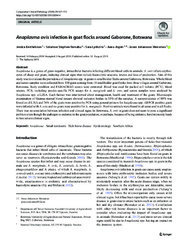| dc.contributor.author | Berthelsson, Jessica | |
| dc.contributor.author | Ramabu, Solomon Stephen | |
| dc.contributor.author | Lysholm, Sara | |
| dc.contributor.author | Aspán, Anna | |
| dc.contributor.author | Wensman, Jonas Johansson | |
| dc.date.accessioned | 2021-11-16T13:17:47Z | |
| dc.date.available | 2021-11-16T13:17:47Z | |
| dc.date.issued | 2019-08-13 | |
| dc.identifier.citation | Berthelsson, J., Ramabu, S. S., Lysholm, S., Aspán, A., & Wensman, J. J. (2020). Anaplasma ovis infection in goat flocks around Gaborone, Botswana. Comparative Clinical Pathology, 29(1), 167-172. | en_US |
| dc.identifier.issn | 1618-565X | |
| dc.identifier.uri | https://link.springer.com/article/10.1007/s00580-019-03044-4 | |
| dc.identifier.uri | http://researchhub.buan.ac.bw:80/handle/123456789/78 | |
| dc.description.abstract | Anaplasma is a genus of gram-negative, intracellular bacteria infecting different blood cells in animals. A. ovis infects erythrocytes of sheep and goats, inducing clinical signs that include haemolytic anaemia, icterus and loss of production. Aim of this study was to evaluate the prevalence of Anaplasma spp. in goats in smallholder flocks around Gaborone, Botswana. Whole blood and serum samples were collected from 100 goats coming from 10 smallholder goat flocks from three villages around Gaborone, Botswana. Body condition and FAMACHA© scores were estimated. Blood was used for packed cell volume (PCV), blood smears, PCR, including species-specific PCR assays for A. marginale and A. ovis, and serum samples were analysed by Anaplasma spp. cELISA. Each farmer was interviewed about management, health and treatment of the goats. Microscopic examination of Giemsa-stained blood smears showed inclusion bodies in 53% of the samples. A seroprevalence of 88% was found on cELISA and 76% of the goats were positive by PCR using general primers for Anaplasma spp. All PCR positive goats were infected with A. ovis and no goats were positive for A. marginale. Positive animals were found in all areas and in all flocks. There was no correlation between infection and clinical signs. In Botswana, A. ovis in goats does not seem to pose a significant problem even though the pathogen is endemic in the goat population, or perhaps, because of being endemic, herd immunity leads to less severe clinical signs. | en_US |
| dc.language.iso | en | en_US |
| dc.publisher | Springer | en_US |
| dc.relation.ispartofseries | Comparative Clinical Pathology,;Vol. 29(1), 167-172. 2020 | |
| dc.subject | Anaplasma | en_US |
| dc.subject | Small ruminants | en_US |
| dc.subject | Tick-borne disease | en_US |
| dc.subject | Epidemiology | en_US |
| dc.subject | Southern Africa | en_US |
| dc.title | Anaplasma ovisinfection in goat flocks around Gaborone, Botswana | en_US |
| dc.type | Article | en_US |

